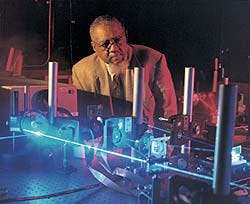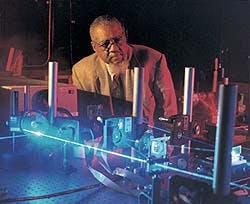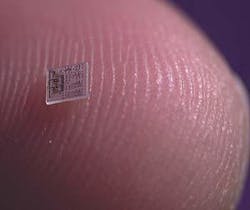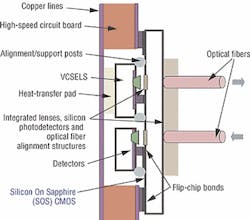By John McHale
Computer designers seek to connect components with optics instead of copper electronics in efforts to jump-start performance and sharply reduce processor susceptibility to electromagnetic interference, jamming, and unauthorized eavesdropping.
Optical computing, which uses optical fibers and signals instead of copper wiring for board-to-board and chip-to-chip communication, promises a dramatic increase in throughput and a big boost in the performance of computer processors. Industry and academic experts say they believe the technology has the potential to increase computer throughput 100-fold compared with state-of-the-art electronic computers of today.
The promise of such computational power has military and aerospace designers salivating at the prospects for optically interconnected systems to drive applications in avionics, vetronics, space flight, and especially computationally intensive sensor applications such as sonar, synthetic aperture radar, sonar, and image processing.
Officials in NASA and the military services also are excited about these prospects because optical interconnects are based on photons, not electrons. As such — and unlike electronics — optical systems are immune to interference from electromagnetic pulse, says Dr. Donald Frazier, chief scientist at the Space Sciences Laboratory of NASA's Marshall Space Flight Center in Huntsville, Ala. Optical interconnects also do not generate stray electronic signals that hostile forces can intercept.
Those looking forward to the promises of optical computing, however, must learn to temper their enthusiasm; optical computers may not come to fruition as quickly as they might like. "Entirely optical computers are still some time in the future — probably in about 10 to 15 years," Frazier says.
Matching I/O and processor speedsFor decades engineers worked to match processor speeds with I/O speeds, which culminated in the processor performance revolution of the 1990s, explains Ray Alderman, executive director of the VME International Trade Association in Scottsdale, Ariz.At that time, engineers did not pay as much attention to improving I/O performance, as they did to boosting processor speed. The result now is that processors are too fast for today's typical I/O technology to handle, he says.
Optical computing through the use of optical interconnects is changing that, Alderman says. The super-high bandwidths that are promised by optical computing, will in 10 to 20 years put the emphasis back on improving processor speeds, he explains. It is a lot like life, a never-ending cycle, Alderman adds.
Optical technology will take computing beyond serial fabrics such as Infiniband and Rapid I/O in terms of I/O performance, Alderman says. Right now the technology is on the box-to-box level, using optical fibers instead of copper wires to connect boxes and there is some work being done on optical backplanes as well, he says.
The technology is about five years away for board-to-board communication, and about 10 years for chip-to-chip, Alderman adds. Chip-to-chip applications will probably use free-space lasers aligned between chips to transmit signals, eliminating the need for fiber, Alderman says. However, this is very delicate stuff and may have problems in high shock and vibration military applications where any jarring or bending of the board may mess up the alignments, he adds.
Current technologyEngineers at Pentair-Schroff in Warwick, R.I., are designing backplanes for CompactPCI that give their customers the option of using optical connectors to run fiber through the backplane instead of wiring, says Mike Thompson, primary engineer at Pentair-Schroff.The price of the backplane whether the customer wants to use optical connections or copper is the same, Thompson says. They will see performance benefits with optical connectors and fiber and will see an increase in costs depending on their application, he explains. Many different companies make optical connectors with the biggest one probably being Tyco in Harrisburg, Pa., Thompson adds.
As the new VITA and PICMG standards come out there will be more and more references to optical point-to-point connections, Thompson adds. For more information on Schroff backplanes contact the company on the World Wide Web at http:// www. schroffus.com.
Box-to-box optical computing is here and good work is being done on backplanes, however, there are still obstacles to be overcome before optical computing is a viable technology, VITA's Alderman says. "The main one being power consumption.
"For example, if a rack has 16 boards and all sixteen boards talk to each other optically each board has to have N-1 optical connectors times 2 — transmit and receive — with N equaling 16," Alderman explains. That comes to 15 optical diodes and 15 receivers on each board, he says. The number of optical connections will then be 2 times N times N-1, which comes to 480 interconnects generating about 2.4 kilowatts of power, Alderman says.
Researchers in Japan at NEC and Sharp and in the U.S. at various universities and the Defense Advanced Research Projects Agency (DARPA) in Washington are working with solid-state devices to transmit the optical signals using significantly less power, but at a higher price, Alderman says. They are solid-state optical devices are called vertical cavity surface emitting lasers, or VCSELs.
VCSELs are a new kind of semiconductor laser that display a very high frequency, greater than 5GHz, and have critically damped relaxation oscillation on the rising edge of the optical signal, which thereby enhances the performance in data communications links, and simplifies engineering design, according to Honeywell's VCSEL hone page on the World Wide Web at http://content.honeywell.com/sensing/vcsel/. Honeywell was the first company to release a commercially available VCSEL, company officials say.
DARPA researchDARPA officials have also been doing extensive research in optical computing, especially in free space lasers and optical interconnects."Optics and optical interconnection in the long-haul and local area networks have proven extremely successful," DARPA officials say. "The next arena where optics and optical interconnection will make an even greater impact is 'in the box' where optics has the potential to solve the electronic interconnect problem at the backplane of boards, between MCMs, and between chips; for example, in processor-to-memory and processor-to-processor communications.
"At this level of hierarchy, optics and optical interconnections have the potential to dramatically increase the speed and capacity of interconnection buses," DARPA officials say. "Next-generation optical memories are projected to increase current storage capacities by at least an order of magnitude; optical volumetric memory concepts will push this limit to densities in the terabits per cubic centimeter range. With parallel access optical interconnections, formed from very large scale integration of optical and electronic devices, the raw transfer rates of these memories will easily approach the 100s of gigabits/s."
DARPA has a related on-going program in Free-space Optical Interconnect Accelerator (FSOIA). Free space optical interconnects, or FSOIs, promise to provide the capability of lower power, higher I/O density, higher bandwidth, and global interconnectivity between chips, MCMs, and boards, DARPA officials say.
"The FSOIA is considered an effective application for evaluating the inherent advantages of combining the advantages of optics for communications and topological transformations with the density and computational power of electronics," DARPA officials say. "The use of FSOIs is anticipated to enable orders of magnitude improvement over conventional electronic techniques in future military and commercial information processing systems."
This DARPA work is focused on advances made in optoelectronic device technologies, optical memory technologies, heterogeneous integration, and packaging technologies to demonstrate data transport rates and reconfigurable I/O capabilities in the 10s of terabits per second range, and rapid parallel access to ultrahigh density memories as they can provide capabilities in future military and commercial information processing systems, DARPA officials say.
"Specifically, this area will address system integration where the interconnection networks between boards, and between the chips within the boards, use transceivers fabricated with large arrays (32 by 32 to 128 by 128) of VCSELs and detectors," DARPA officials say. "Innovative architectures that take advantage of the optical interconnection fabrics at the component and system level implementation are sought."
DARPA officials were unavailable for comment on specific research when Military & Aerospace Electronics went to press.
NASA researchScientists at the NASA Marshall Space Flight Center in Huntsville, Ala., are working to create optical films that in the future could replace electronic circuits and wires, making the systems more efficient and cost-effective, as well as lighter and more compact, NASA officials say.The NASA team uses lasers shining through a quartz window into a special mix of chemicals to generate a polymer film on the inside quartz surface. As the chemicals respond to laser light, they adhere to the glass surface forming optical films. Programmed patterns of these films can then be traced onto the quartz surface.
" Electronic signals, even with Very Large Scale Integration (VLSI) and maximum miniaturization, are bogged down by many aspects of the solid materials they travel through," NASA's Frazier says. "So we've had to find a faster medium for the signals — and the answer seems to be light itself."
A science team led by Frazier, working aboard the Space Shuttle formed optical computing thin-films with fewer impurities than those formed on Earth, NASA officials say.
"Electro-optical hybrids have been possible since 1978, when it was learned that photons can respond to electrons through media such as lithium niobate," NASA's Frazier says. "Newer advances have produced a variety of thin films and optical fibers that make optical interconnections and devices practical. We are focusing on thin films made of organic molecules, which are more light sensitive than inorganics. Organics can perform functions such as switching, signal processing, and frequency doubling using less power than inorganics. Inorganics such as silicon used with organic materials let us use both photons and electrons in current hybrid systems, which will eventually lead to all-optical computer systems.
"What we are accomplishing in the lab today will result in development of super-fast, super-miniaturized, super-lightweight and lower-cost optical computing and optical communication devices and systems," Frazier says.
The speed of computers has now become a pressing problem as electronic circuits reach their miniaturization limit, NASA officials say. The rapid growth of the Internet, expanding at almost 15 percent per month, demands faster speeds and larger bandwidths than electronic circuits can provide, NASA officials say.
Terabit speeds, or 1 trillion bits, are needed to accommodate the growth rate of the Internet and the increasing demand for bandwidth-intensive data streams, says Dr. Hossin Abdeldayem, a former member of Frazier's optical technologies research group. Optical data processing can perform several operations simultaneously (in parallel) much faster and easier than electronics. This "parallelism" when associated with fast switching speeds would result in very high computational power. For example, a calculation that might take a conventional electronic computer more than eleven years to complete could be performed by an optical computer in a single hour, NASA experts say.
"All-optical switching using optical materials can relieve the escalating problem of bandwidth limitations imposed by electronics," Abdeldayem says. "In 1998, Lucent Technologies introduced a lithographic submicron technology to further miniaturize electronic circuits and enhance computer speed. Additional miniaturization of electronic components only provides a short-term solution to the problem. There are also physical problems accompanied by miniaturization that might affect the computer's reliability."
Drs. Frazier and Abdeldayem and their group at Marshall, have designed and built all-optical logic gate circuits for data processing at gigabit and terabit rates, and they are also working on a system for pattern recognition.
"We have also developed and tested nanosecond optical switches, which can act as computer logic gates," Abdeldayem says.
"Picosecond and nanosecond all-optical switches, which act as AND and partial NAND logic gates were demonstrated in our laboratory," Abdeldayem explains. "Such logic gates are members of a large family of gates in computers that perform logic operations such as addition, subtraction and multiplication. They are vital for the development of optical computing and optical communication. Our all-optical logic gates were made using a thin film of metal-free phthalocyanine compound and a polydiacetylene polymer in a hollow fiber.
"Logic gates are the building blocks of any digital system," he continues. "An optical logic gate is a switch that controls one light beam with another. It is 'on' when the device transmits light, and 'off' when it blocks the light."
"Our phthalocyanine switch operates in the nanosecond regime (i.e., gigabits per second), functioning as an all-optical AND logic gate," Abdeldayem says. "To demonstrate it, we waveguided a continuous (cw) laser beam co-linearly with a nanosecond pump beam through a thin film of metal-free phthalocyanine. The output was sent to a fast photo-detector and to an oscilloscope. The cw beam was found to pulsate synchronously with the pump beam, showing the characteristic table of an AND logic gate."
"Our setup for the picosecond switch was similar, except that the phthalocyanine film was replaced with a hollow fiber coated from inside with a thin polydiacetylene film. Both collinear laser beams were focused on one end of the tube, and a lens at the other end focused the output onto a monochrometer with a fast detector attached. The product of the two beams demonstrates three of the four characteristics of a NAND logic gate."
"Optical bistable devices and logic gates such as these are the equivalent of electronic transistors," Abdeldayem says. "They operate as very high speed on-off switches and are also useful as optical cells for information storage."
These all-optical computer components and thin-films developed by NASA are essential to the current worldwide work in electro-optical hybrid computers - and will help to make possible the organic optical computers that will be the standard of future terrestrial and space information, operating, and communication systems, Frazier says.
Honeywell introduces STABILAZE VCSEL arraysEngineers at the VCSEL Products division of Honeywell in Richardson, Texas, recently released VCSEL (vertical cavity surface emitting laser) arrays that are stabilized at the wafer level.The STABILAZE 850nm VCSEL arrays eliminate the typical concerns about parametric shifts of the output caused by temperature and current, Honeywell officials claim. The devices ensure uniformity of characteristics such as threshold, slope efficiency and resistance, which improves laser performance and eases design for manufacturers of parallel optical interconnect high-speed data transceivers and other applications, company officials say.
The array's tight lognormal distribution gives it a projected lifetime seven times better than would be calculated from individual element reliability using random failure distribution assumptions, Honeywell officials claim.
"This discovery will revolutionize the way VCSELs can be applied and offers tremendous value to our end customers," claims Paul Chapman, vice president and general manager of Honeywell's VCSEL Products division.
The stabilized and fully tested HFE8004-101 and HFE8012-101 are VCSEL array die in a 1 by 4 and 1 by 12 configuration, respectively, and feature speeds in excess of gigabits per channel with drive currents between 3 and 12 mA, Honeywell officials say. The companion detector arrays are HFD8004-101 and HFD8012-101. VCSEL and detector arrays are available for high-volume production. Custom arrays (one and two dimension) are available as well, company officials say.
For more information on Honeywell's VCSEL products, contact the company by phone at 800-784-3011 by fax at 815-235-6545, by email at [email protected], or on the World Wide Web at http://content.honeywell.com/sensing/vcsel/.
Johns Hopkins researchers design optical interconnects for chip-to-chip communicationEngineers at Johns Hopkins University in Md., are using mini-lasers and silicon on sapphire technology to design faster and cost-effective interconnects between computer chips. By using light beams in place of metal wires, the Hopkins researchers have devised a cost- effective way to speed up the way microchips "talk" to each other.The method, created by a team in the school's Department of Electrical and Computer Engineering, takes advantage of unusual characteristics associated with silicon on sapphire technology, a new way to manufacture microchips.
"We've developed a very fast and cost-effective way of getting data on and off a chip without using wire," says Andreas G. Andreou, a professor in the department and director of the lab in which the work was done. "It really promises to revolutionize how computer systems for homes and businesses are put together."
Andreou's team relies on the same fiber optics technology that is used to carry phone conversations across great distances, Johns Hopkins officials say. These components are incorporated into a new type of microchip technology. The microchips inside most modern computers are assembled on thin slices of silicon, a material that is a semiconductor. The Johns Hopkins engineers use microchips in which silicon is layered onto thin slices of synthetic sapphire, a material that is an insulator and also allows light to pass through it.
In the microsystem devised by Andreou's team, a signal that originates in a wire is transformed into light and beamed through the transparent sapphire substrate via a laser that is only slightly larger than a human hair. Microlenses and other optical components, manufactured at the same time as the electronic circuits on the microchip, collect the light beam and guide it to another place on the microchip or, using an optical fiber, move it to another chip.
Key components in the microsystem are solid-state devices called vertical cavity surface emitting lasers, or VCSELs.
At its destination, the light enters a high-speed optical receiver circuit that transforms the stream of photons into a stream of electrons that continue their journey through electrical wiring connected to other computer components. By using optical signals, or simply an unhindered laser beam, the Johns Hopkins researchers say they believe a signal could move 100 times faster than it does along a metal wire.
The optoelectric interface circuits also require much less power because the sapphire substrate is an insulating material, not a semiconductor, says Alyssa Apsel, a doctoral student in the Anderou lab who helped developed the system. This property of the substrate reduces the power dissipation that commonly occurs in modern microprocessors when signals travel through wires that have capacitances, which are parasitic components that not only degrade the signals but also increase the power consumption of the system.
The new design is expected to significantly speed the movement of data between electronic components across a single chip and from one chip to another for a simple reason: "Without the parasitic capacitances, it's much faster to send signals at the speed of light," Apsel says.
Apsel says she believes the chip-to-chip optical communications will be a common chip-to-chip technology in about five years.
Peregrine Semiconductor in San Diego provided silicon on sapphire material used by Andreou's team, Apsel says.
The project was supported by grants from the Army Research Laboratories and the National Science Foundation.






